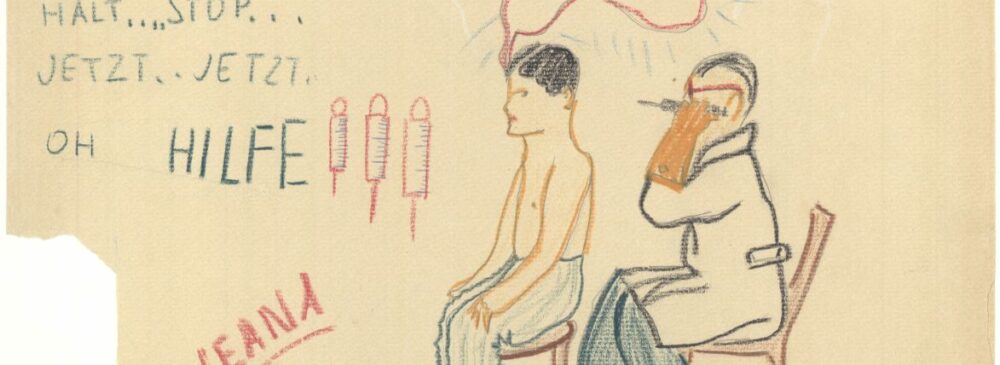Three with a Pen on a Journey
Mar 25, 2021 | JMW News

Just over a year ago, “Traveling in the Time of Corona” would have sounded like a cheap copy of the novel “Love in the Time of Cholera” by Gabriel García Márquez. Today, the more pragmatic question flashes up: “With or without the corona test?”
Lily Renée, Bil Spira and Paul Peter Porges (called PPP), the protagonists of the exhibition “Three with a Pen” (Museum Judenplatz, 2019), traveled a lot in their lives. Not only did the trio have in common their extraordinary talent for drawing, which they used very differently, but also the expulsion from their hometown. They embarked on this life-changing and certainly extremely disturbing journey at very different ages, and their Vienna was probably different than the one they had experienced up to that time. Bil Spira was already 25 years old when he fled. He frequented Social Democratic and cabaret performers’ circles in Vienna and had already fallen in love twice: in Paris, and with his future wife Minna. Lily Renée and Paul Peter Porges both received a place on a Kindertransport. Lily Renée had grown up as an only child in a middle-class family and was just about to turn 18 at the time. PPP had lived with his family in the working-class district of Fünfhaus (today Rudolfsheim-Fünfhaus), where he had spent a lot of time in his parents’ grocery store. Just 12 years old, he was the youngest of the “Three with a Pen” who, like many others, had to flee.
Infectious diseases were nothing new to the three of them. PPP wrote about its Viennese neighborhood: “The children on Moeringgasse in the 1930s were malnourished and in poor health. Epidemics like diphtheria were normal.” Parents who registered their children for a Kindertransport had to confirm by signature that they did not suffer from any infectious disease. Although the children were medically examined on their arrival, a mumps and rubella epidemic nonetheless broke out in the Children’s Republic of La Guette, where Paul Peter Porges ended up after the Kindertransport with around 140 other children. Based on one of the drawings with which PPP documented his life there, we can assume that the children were vaccinated, possibly against smallpox – because there was no vaccine against rubella or against mumps and measles at this time.

Paul Peter Porges
It´s perfectly alright to be a swine, New York, around 1990
© Jewish Museum Vienna
Lily Renée did not come to France like PPP, but like most of the children who were able to escape from Vienna with the help of a child transport, to Great Britain. But she did not stay long with the family who had taken her in. Just as her parents did a year earlier, she also reached Ellis Island in 1940. There, too, the newcomers were always subjected to medical examinations; in addition to infectious diseases, greater attention was paid to mental health and pregnancy. Lily Renée had developed a keen imagination even as a child, by means of which she had often dreamed herself out of the dreariness of childhood boredom. She probably also used this ability during these difficult times when she had to make her way to America on her own. A drawing from 1939 that she made in Vienna and represents a well-known place of longing has survived.

Lily Renée
Sehnsuchtsphantasien nach einem Inselleben, Vienna, January 1939
© Lily Renée collection
Bil Spira was able to flee to France and forged passports for the American escape helper Varian Fry, with which he saved the lives of numerous people. He himself was betrayed in 1941 and subsequently survived several internment and concentration camps. When he was liberated from Theresienstadt in 1945, he had managed to keep a few drawings that he had made during his imprisonment. In the camps, epidemics and parasites were rampant due to the inhumane living conditions. The liberators fought rigorously against this and so the drawings were burned “for hygienic reasons” by the “Russian disinfection tovarishch,” as Spira wrote in his autobiography. He felt this loss for the rest of his life. Presumably, he did not find out in time that a British prisoner of war had succeeded in smuggling some of his drawings – which he had received in exchange for cigarettes – out of the camp. Today they are kept at the Imperial War Museum in London.

Bil Spira
Hans Thimig, Vienna, 1930s
© Jewish Museum Vienna
When looking back at the life and work of the “Three with a Pen,” the epidemic aspect fades into the background. Their artistic achievements were far too great and much more interesting. Paul Peter Porges developed a sense of humor which brought him success in intellectual New York, as well as in the crazy “Mad Magazine” or in “Playboy.” Lily Renée had superheroes fight the Nazis in her comics or contemplated stories about the origins of colors, which she told and illustrated in the children’s book “Red Is the Heart.” Bil Spira enchants people with his skillful use of empty spaces and reduction. One can only marvel at his ability to distinctively portray a person with just a few strokes.
But back to the beginning: Cholera originally comes from Greek. Via Latin, it made its way into Romance languages such as Spanish, where there is a second meaning: rage or anger. This can also be identified in the “Choleriker” (choleric person) known in German. At the end of Márquez’s novel, the lovers hoist the cholera flag in pretense to seal themselves off from “the horror of real life.” The “Three with a Pen” experienced a lot of suffering and injustice in their lives and would probably have liked to hide from the cruel world from time to time. Only Lily Renée, who celebrates her 100th birthday this May, is experiencing the current pandemic. Corona can be found in Spanish and Italian as an unloaded word that simply means wreath or crown. In any case, despite the Corona virus, our exhibition finds a crowning continuation in New York, because it is allowed to travel (without a test) and will be on view at the Austrian Cultural Forum from March 11, 2021.
Cover image:
Paul Peter Porges
Impfung in der Kinderrepublik La Guette, Summer 1939
© Jewish Museum Vienna
